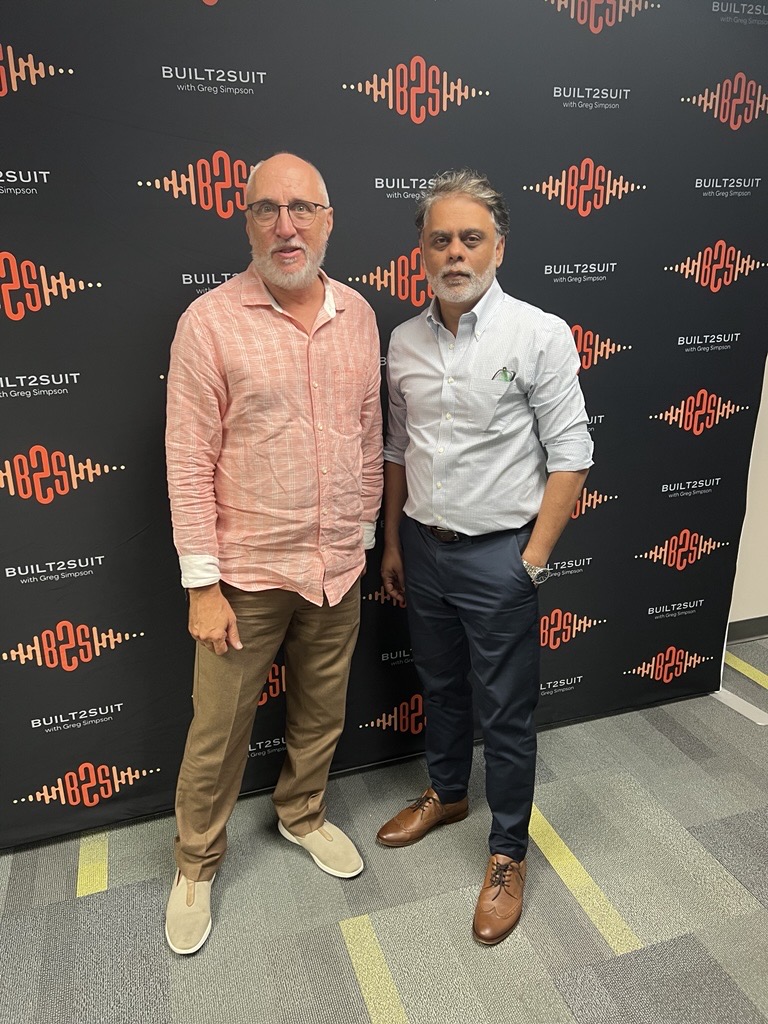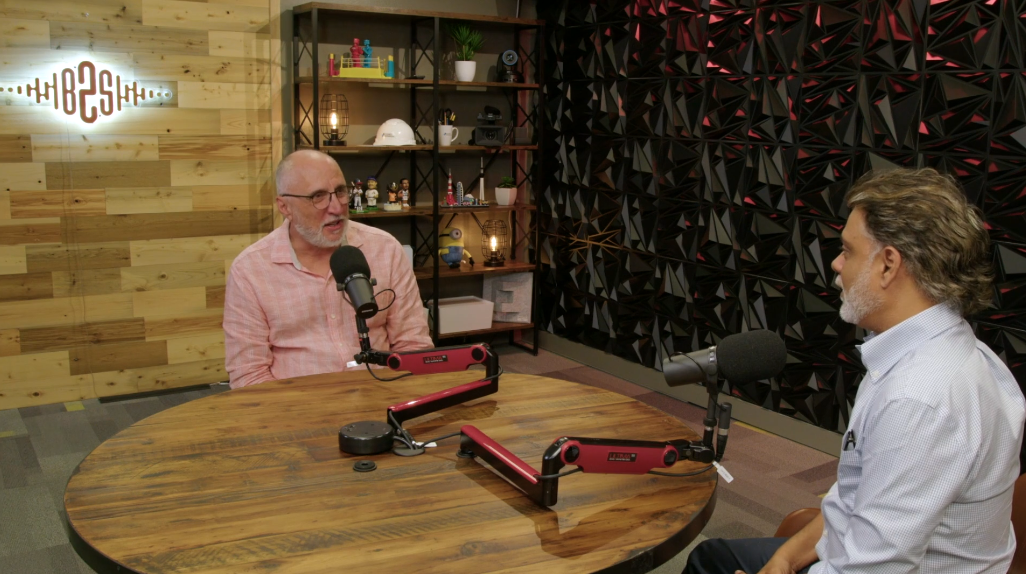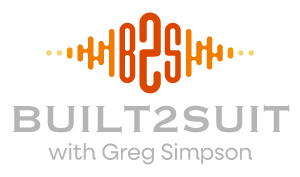
Krishna Rao’s Journey with Studio Parametric:
In this premiere episode of the Built2Suit Podcast, host Greg Simpson sits down with Krishna Rao, founder of Studio Parametric, for a candid and inspiring conversation about architecture, entrepreneurship, and cross-cultural collaboration. From his early days in Bangalore, India, to his studies at the Parsons School of Design in New York, Krishna shares how his experiences have shaped his design philosophy and career trajectory.
Listeners will hear how Krishna transitioned from working at renowned firms like Perkins Eastman and Fox & Fowle to founding his own company, Studio Parametric, and eventually partnering with CP to deliver BIM and architectural services worldwide. The episode explores the challenges and rewards of building a business from scratch, the cultural contrasts in architectural practice between India and the U.S., and the evolution of a partnership that’s redefining value creation in design and engineering.
Whether you’re an architect, entrepreneur, or just curious about global collaboration in the built environment, this episode offers valuable insights and a compelling story of vision, resilience, and innovation.
These are the voices that move the market. This is BUILT2SUIT.
Listen on:
Episode Transcript:
Had the itch or the urge to do something on my own. So I was getting to a point in my life where I was like, okay, you know what? Really, if I want to do something, I was about. At that point. You'd say, okay, if I do it, I do it now or else I'm not going to happen. It's not going to happen.
Certainly welcome in. Thank you. Very happy to have you here. A lot of our staff knows about SPA. They know about our India program that they don't always get to put a face on it because so many of them don't interact with 'em. Some do, I think our engineering team perhaps a little bit more, so I thought it might be nice to have you in today to just have a conversation with me. We've built a relationship that I think is really cool. Both architects kind of geek out on that from time to time, but all our journeys are so different, but yet there seems to be similarities. So tell me just a little bit about your early years, how you went to college, what brought you to the states?
Well, first of all, thank you, Greg. I think, actually, to be honest, Jason gave me a heads up that you're going to be talking to me. I wasn't sure what the subject or the topic of this discussion would be, but I think what you just laid out to me, I don't think I need any preparation. I think I can talk about it. You can talk about your own.
I don’t need a cheat sheet. You don't need a cheat sheet to talk about your own.
I don't. What am I going to tell Greg? No, that's cool. No, no, no. This is great. So yeah, I am originally from Bangalore, India, which is in the southern half of India. My father was an engineer. I used to build single family homes, so I used to go to construction sites, even as a kid, although I didn't understand much, but I sort of saw the brick and the mortar coming together to create these homes, basic homes. But I was on construction sites and around buildings since I was a kid. So I ended up going to architecture college in India. That's where I did my undergrad. And then once I finished my undergrad in architecture in India, then there was the urge to sort of widen my horizon, gain new perspectives, and I said, well, why don't I go to the States? And I ended up going to grad school at Parsons School of Design in New York.
I finished my master's in architecture, which to me was actually, to be honest, Greg, the way the education system works in India versus the states is very different. In India, it's more rote. I think it's because of the way the British have trained us. It's more technical. And then I come to Parsons where it was all about don't worry about the structure, don't worry about if the building functions, think about the idea, the concept, which to me was a new thing because when I was studying for my bachelor's in architecture, it was all about, okay, what's the square foot of the building? Do you think the columns are on the right grid? It's so functional that it was like jumping from one ship to the other, and it took me a while to get a hang of that.
I'm ure you sort of understand what I'm saying. I understand the design element Is that they're much more focused here in the states of being a design school and being able to be a good critical thinker and to create space and ideas that are highly conceptual and can kind of apply to the building. I can see that that's probably the more difficult element to go get than perhaps the technical part. But I'm really more interested in, you talked about the difference in architectural school. I got to believe there's a real difference in just culturally what you were experiencing in India, and then when you came to the States, what that must have been like.
Well, I think I'm also talking about the early nineties. So things have definitely changed even in the education system in India. But when I was going to college in India, like I said, the focus of all the courses was very technical, very functional oriented, more towards can you put a building together, coordinate with all the other trades. It wasn't about what wasn't about the idea. There was no great idea that was necessary. It was about can you put things together and make sure you can deliver it in a certain time on a certain budget. And then I get to Parsons, which is an extremely concept-oriented design school. I still remember the first crit that we had designed a studio here. I was drawing upstairs and toilets and things like that, and my other colleagues, they had these blobs and shapes and everything's pinned up on the wall. I'm looking at this, I'm thinking, what am I doing different, is there something wrong with me? So then I had a chat with my professor, and he sort of explained, I get it that you want to see how the stair functions, but it's also important to think about the overall idea. So it's just conceptually so different that it took me a while to understand that we can get back to the toilets and the stairs later, but what's the big idea?
It's very different.
Well, you get to New York City, that's got to be somewhat different than Bangalore for sure. You get through college and now you have to decide what you're going to do. I, so how do you make that decision, and where does that decision lead you?
Yeah, getting to New York, like you said, was a big eye-opener for me. In fact, when I got my admission to Parsons and before I left the States, because this predates the internet, so there was no way for me to even understand how the life in New York would be. My only exposure to New York was through movies, Hollywood movies. So what happens right before my travel to the US, there's a movie that releases, it's called The Devil's Advocate, Al Pacino and Keanu Reeves, I think Keanu Reeves. So my friend and I, we say, okay, that's set in New York, so let's go see the movie. And I think when I landed in New York, I realized, that's not the movie you want to watch because people living in Park Avenue and these glass skyscrapers, that's just a minority of the city. I ended up living in an attic in Queens so far from the movie-like setting in Devil's Advocate. So it was New York was overwhelming, but I loved it. I still love it. It's a great place.
So you get out of school, you get in a position to further your career. So where do you end up?
Right. While I was doing my grad school, I started talking, applying to a few firms. As we were ending my semester, I started applying to firms, and this was in 1999, so just before the Y2K thing happened, and there was a lot of focus on the technology at that point. The dotcom bubble still hadn't burst. So everybody was talking about the internet and the .com. So architectural jobs weren't that easy to come by. But luckily I was able to get an internship at SOM, Skidmore, Owings & Merrill, a small firm, small firm. Most people would’ve heard of them. They're all over the place. But the one thing I would want to say on record is I think that's not a right place for a young architect to be, only because it's such a big place. You don't really end up being noticed. Nobody notices you, at least with me, I was lost.
So once that was done, then I said, okay, what am I going to do? So I got a job at another firm, also not so small, it is called Perkins Eastman. There were about a thousand people back then. I think they're at 1500 at this point, but also in New York. And funny enough, one of the reasons I took that job was their address said 115 Fifth Avenue. So given my sort of connection with Hollywood movies, I was like Fifth Avenue. That is New York. Anyway, I went to the interview. I ended up working for Perkins Eastman, worked on a couple of tall buildings. So that was my first exposure to actually working on high-rise buildings. And my senior architect at that time, his name was Mike Gordon. In fact, we had a conversation about tall buildings, and I said, Mike, you know what? The floor's all repetitive. So you do, one gets sort of copied up. So isn't this not challenging? So that's when he told me, yes, it's probably repetitive, but the thing is you make a mistake and you repeat it 20 or 30 times. So you got to be really careful with high-rise buildings. So that's the nuance that you need to remember when you're working on tall buildings. So that's something that I can recall from my first job, first real job at Perkins Eastman.
So somehow your journey got you all the way back to Bangalore. It started a company, a company that we now work with in partnership, I think more than in as a contract subcontract relationship. So tell me how that got started.
Yeah, so I think I do agree with you, Greg. I don't think it's a transactional relationship. I think we are working together as partners. So Studio Parametric happened. So after Perkins Eastman, I went to work for a company called FXFOWLE Architects, a mid-size New York firm. And the reason I ended up there was because they had just won the award for the New York Times headquarters, which was being designed by Renzo Piano and FXFOWLE was the architect of record. So I really wanted to work on that project. I was able to get a job, and I also got a chance to be on the project team with Renzo. So that to me was a big highlight. We did that for a year, and I stayed with them for about almost 4 years. By the end of that 4th year, I was their director of digital design, meaning I was focusing on implementing Revit and helping them with all things BIM.
But at the same time, I've always had the itch or the urge to do something on my own. So I was getting to a point in my life where I was like, okay, you know what? Really, if I want to do something, I was about 35. At that point. You say, okay, if I do it, I do it now or else I'm not going to do it. It's not going to happen. So I spoke to my manager, who was also one of the partners at FXFOWLE. I said, listen, I want to go back to India. So he made me an offer. He said, that's fine, you can go back, but do you want to continue working for us from wherever you are? I said, yeah, I mean, who's going to refuse that deal? That's how it started. I had to set up a company, came up with a name, and interestingly, the name for the firm happened. When we were on a drive, my wife and I, we were driving to Cleveland from New York, and the topic was, okay, how do we set up the company? We had no idea how to do this, but we wanted to do it. So the first thing was, what do we name the company? So we had a lot back and forth. That's a seven or eight hour drive. By the end of that, we came up with the name Studio Parametric. So that's interesting.
You've run through every other name possible in that period of time?
Pretty much. We wrote down a lot of names. They checked it on the internet to see if there are other firms of the same name. So yeah, that drive from New York to Cleveland yielded us the name for the company.
Did you start off as an employee and then it kind of blossomed into a kind of affiliate relationship? How did that really come to be?
Yeah, so no, I didn't start as an employee. So the expectation was clear that if I was going back to India, I would be on my own. I would be owning this company called Studio Parametric, and FXFOWLE, who was my employer in New York, would basically have me help them on some of their Revit projects because at that point of time, I was heading their BIM slash Revit efforts. They were short-staffed, short-skilled on that software. So they needed me, and I also, to me, that was a lifeline. I said, let me try it. If it doesn't work out, I'll come back. So I was not an employee, but I was basically working as a consultant and providing services to my former employer. So it was just me. And after about three months, they said, well, this seems to be going well. Do you want to add another person? I was like, okay. And I was able to find another person, and then slowly that sort of picked up. By the end of two years, we were up at about 15, 16 people, all of us working for this one firm that I was with previously. So that's how the journey started in 2008.
So you obviously had some element, not of citizenship, but certainly you got your green card in order to come to New York and to participate with that firm. So I know you wanted to expand maybe beyond what was going on with the initial firm. So how did that start to happen where you started to shop yourself out to other firms, either in the states or worldwide?
So before I went back, I just had got my green card. So that gave me the wings to say, well, let me do something on my own. But I also wanted to make sure that FXFOWLE had sponsored my green card. I didn't want to just cut the relationship, and they didn't want to do that either. So this gave me a way of doing both going back to India, doing something on my own, still being tied to FXFOWLE. So the first two years was exclusively for them, but since I worked for so long in New York and I knew people and they had now moved on to different firms, I started reaching out to them and saying, Hey, you know what? Remember me from so and so. I have a firm. I do this. So I would travel to the States a couple of times or maybe three times a year and try to meet people that I knew and just sort of offered my services and say, listen, this is what we do for FXFOWLE.
We can do that for you guys. So slowly but surely that sort of picked up. I think by 2012, 2013, we were up to about 30 people working with about four or five different clients. So we didn't have any business relation team. It was just me reaching out to my connections or maybe through referrals work coming to us. So that's how we built up the business until we got to a point in 2014 where I felt like, okay, I think we are going to make this. Because the first couple of years, to be honest, Greg, and you probably understand this as much as I do, is you see the business ups and downs and you start to worry, how bad will this be? Can we survive this? So there are a lot of challenging moments.
I can imagine. But I'm intrigued. You talk about doing work in the States, but I'm more interested at this moment of your worldwide connections because you've told me you've done work in the Middle East. You told me you've done work in the UK. You've told me you've done work in Australia. So how did that start to come to be?
Right. So we've done work in Qatar, in Dubai, in Saudi, in Abu Dhabi, UK of course, and Australia in Singapore a little bit. So yes, we've done work around the world, but the bulk of the work that we do, I would say 80% of it is in the US. Middle East, we did a lot of work prior to COVID, but then we had a challenge because everything stopped during COVID, and we have been careful about reentering that market. We are still doing some work, but very selective. Qatar, we did a lot of work up to the FIFA World Cup in 2022. After that, it's been really slow. There is some work, but again, not much. So how did we get into these markets? I think it was mostly because of the relationships that I had built over the years and people who knew me or who knew of me, and just going out and pitching the service.
And one thing that made us different was we were a small firm, but we were very focused, and I was quite hands-on with the projects until a certain point where to our clients, it gave them a sense of assurance that the person who's running the firm is also the person talking to them about getting this new business. We didn't have a business development team just going out there and selling on our behalf. I was there in front of our clients and saying, okay, this is what we do, and I can tell you this is all that we can do. We won't be able to do something else. So we were quite clear about the expectations, and I think that made the difference.
Well, we've talked about work that you've done for affiliates worldwide. You're an architect, right? Yes. You're an Indian architect in the country. So describe a little bit the differences between maybe architecture, how it gets executed in India. I can certainly see when we talk to your team members, they get confused about some of the things in the states, the more regulatory things and other things. So this might be a good opportunity to explore why they would feel that way and what's different about working inside India.
So for those of the audience who don't know, we have a design practice studio. Parametric is the BIM sort of service that we are working in collaboration with you guys. We have a design practice called Terra. So we function as an architectural firm in and around Bangalore mostly. So the practice of architecture is very different from the way it is done in India. For one, the compliances and the regulations that you see in the states or in the west compared to what you see in India, highly diluted. It's there on paper. We pretty much work off the same building codes, but the enforcement, the compliance is I would say, far less rigid. The other thing is just the construction methodology. It's a completely different way of putting buildings together. Most folks in India would not have seen drywall. I mean, you see it in India, but in base building work, you hardly see any drywall. You will almost never see wood frame construction, steel construction, limited. It's mostly brick and concrete and cement and mortar. That's
Is that because of just having indigenous materials, you can just build them up on site?
Exactly. It's very easy to execute. The availability is there.
Exactly.
You don't have to have highly industrialized processes like you do with steel. It makes all the sense in the world. But I was kind of hearing that at least in more contemporary times, steel is becoming a pretty popular choice for larger scale work. Is that real?
I think it is picking up, but again, one thing we need to realize about India, Greg, is the availability of labor. There's no shortage because there's so many
People. So the labor cost beats material cost, and that's probably 180% opposite from how we do things in the West. Absolutely. Everything's about trying to manage how easy something is to put together.
Exactly. That's one of the main reasons why I think India or South Asia hasn't gravitated towards steel construction or more industrial methods of construction. It's still highly labor-intensive. That's because you get labor and it provides jobs.
So 2015 comes along, you connect up with Jason Mraz of our firm at some point. Describe that just a little bit. Your first interaction with CP.
Yeah, 2015. The interesting thing about that first meeting, Greg, is that at around 2014, 2015, we actually set up a business development team. Until then, I was pretty much doing all of that. So we had a couple of guys who were basically calling firms in the US and saying, Hey, we do BIM services, would you be interested? So one of those calls lands up with Jason, and while this is happening, I'm in the States in New York with my former firm doing some meetings, and my guy from India calls me. He says, sir, we have a meeting in Orlando. It's with Jason Moreraz, a company called CP, and when is the meeting? It's tomorrow. I was like, do I really need to fly to Orlando tomorrow? I would say I was on the verge of not flying down, but at the last moment I said, you know what? You don't want to say no to any meeting. So I took a flight, came down here, and I remember there was a huge storm when I landed in Orlando.
There's never huge storms. No, not in Orlando.
Exactly. Yeah. So I did. So that's how the meeting happened. I came, stopped by, met with Jason, and then yeah.
So you describe, you've said it a couple of times here, kind of BIM services. It's kind of what brought you into the market space. But yet when you look at what we are trying to create over these last three or four years, we may have started there with some of the Walmart model development in those early days, but it really has taken on much different contours along the way. So describe the pain that you were feeling when you were going to have to bring on engineering talent to support us.
Yeah. I think what we are doing with CP is very different from what we do with the other firms because I use the word BIM slash production slash work sharing because essentially that's what most of the firms are looking at is to help them with production. Don't worry about moving up the value chain. That's where you will end up staying. That's what we want you to do, and that's fine. But when we started talking to each other, and I think when Jason started the initial discussions, he was very clear. He said, I don't want drafters. We want architects and engineers. So I think we did a lot of hiring very specifically for CP with the intention that we are going to move up the value chain. Yes, like you said, we start with Walmart remodels, existing conditions, models, that was our sort of foot in the door, and then sort of move up the value chain where we can actually support you as architects and engineers. So yes, it's been a strategic sort of direction that we have taken with CP in collaboration with you guys.
Well, did you ever feel like you've made the wrong decision?
No, I think, honestly, no, I don't think so because I think it's more rewarding for folks in our office when they are expected to be taking decisions rather than just somebody telling them, this is what you need to do. Get this to me by the end of the day. Don't ask me questions. So I don't think anybody would not want to do this. So I think this has been great,Namely, and in fact, the team in India wants to do more. So I don't know if that's a good problem.
We've always, from the beginning, Jason and I, when we contemplated this was we wanted to be able to do everything in India that we did in the States. That was clearly a tall order with a 12 and a half or whatever the time change is there from eastern to time in central India. But it was always something that we wanted. And frankly, we were talking just a little while ago on our first visit. We met with a firm that didn't offer that, and it really pushed me back to the point I didn't think, I thought we'd wasted a trip to go over there.
And we talked with Naveen. I remember you were in the States, so I didn't get a chance to meet you while we were there. We have since met a lot of times. I don't think this started out the way we wanted it to or you wanted it to. I think we had a hard time trying to convince ourselves and our teams that what we were doing had us going up the value chain, and it wasn't a consultant-type relationship. And I think that went on for probably three or four years up till probably the fall of last year when we made some changes with our number one client, and those changes started to kind of watershed toward rethinking. I think it actually shuttered through your office, and you lost some folks as a result of that. And I can remember us talking through that at the time and you saying, well, maybe this is happening for a good reason, not a bad reason. And I wasn't so sure, but I think Jason and Josh really set the stage in February of this year when they went up. When I went in April, I was stunned at the energy level of the team. And so describe what you think has happened maybe in the last year that thinks we maybe can change the value chain a little bit.
Yeah, no, I clearly remember, I think last April, April of 2024, April-May is when a lot of movement happened on the Walmart team for us initially, and the signals we were getting were very, it was difficult for us to manage the team internally. We had a lot of people who left because of some of the negativity that was coming through for various reasons. But I think what's changed for us since I would say November of last year has been the fact that there's more transparency. There seems to be a very clear message as to what does CP expect from us as a team? Where do they see us? And the one thing I want to mention to you, Greg, is CP is one of the few clients who's made the effort to come down to our office repeatedly, right? From you as a CEO to, we've had architects, engineers, designers coming down and spending time with the folks.
I think that's really got them involved in this. And people who are working on the CP stuff, they see that. They see the commitment. And I think it's been, as I said, the messaging has been very, very clear since about November of last year. And I think a lot of the credit goes to Jason and Josh when they came down in February. It was a no-holds-barred sort of discussion as to, okay, what went wrong at CP? What is it that we can do? And what is it that SPA can do to make sure that this is a success? So I think it's been a very positive last six to eight months, in my opinion.
I think the transformation I saw in Josh was pretty wild. When you visit, when you see it firsthand, it changes you. Yes. It just changes you because you realize the people that sit in that office over there, I always say there's 1.4 billion reasons that there's motivation in India, and you said that a little bit with labor and other things, just the energy level around. And to think that a lot of these folks that you have in your employ are winning. They're culturally winning in that economy. And I think it's easy for us to get lost in the states that we get caught up on work-life balance, and those are wonderful things, but there just has to be a tremendous amount of energy to survive in Bangalore.
Yes. You've seen that firsthand.
In fact, I remember, I think we were driving out to a lunch, you and I, and then you saw a guy with a computer on a motorbike, and you took a picture of that. So yes, strange things happen out there. Energy levels are high. But yeah, no, I think it's been great for us, especially, like I said in the last six months, Josh coming down, Jason coming down and being, I think very communicative about what is it that they would want us to do, where do they see us? And just helping us with the vision, I think gives a lot of motivation to the team so that they know that, I mean, at least they know a big picture. It's not like they're just working on a drawing. That's the most difficult thing. When somebody comes up and says, I've been doing the same set of drawings over and over again, but at least now they have a vision, which is what I think we all need.
I think that it's really easy to get caught up in just going through the motions and not really understanding what makes you better. I think that that group, especially the engineering group, I think Jason has done a really tremendous job in trying to understand how to get engineering into, I won't say transactions, but being able to solve the individual processes so those can be pressed across and those can be learned. I think from an architectural point of view, I think we are mountains behind because I think there's a logic that everything has to be different. Not everything can be the same and the processes can't be broken down, but we came to a learning that everything we were struggling with, with our teams in India, we were struggling with the people behind us. So it was the basic training, the training of one, if you've got a person in front of you that knows what they're doing, they can do a great job, and they will continue to do that great job until they have to delegate. But once they have to bring someone alongside them, can they teach them? And that has been the limitation we've seen to this point in India, but it's also been the limitation we see in our own studios. And so that's really the breakout I think, that we're really, really, really looking for organizationally. But I think we have done a significantly better job. Absolutely. And the energy level in April when I was there was just off the charts. What do you see as the future for how you want to be operating with CP?
Well, predicting the future, that's always loaded. But the way I see this partnership going is that, of course, we want to keep building on what we've done so far. And I just want to take a moment here to sort of talk about Jason, because he's been instrumental in guiding us in the sense that he's been the one who's been saying, okay, this is what works. This, it doesn't work. This makes sense, doesn't make sense. Because I think he gets the pulse being from India. He understands the psyche of what might be happening in SPA. And since he is at CP, he understands the thinking on both the sides. So he's been a great bridge in terms of making this collaboration successful. So in terms of the future, I think, Greg, we really want to move up the value chain. We want to do more stuff.
We want to be doing stuff that is, like you said, anything that can be done here should hopefully potentially be doable in our office in Bangalore. And I also see that there is a chance for us to even look at doing work outside of the US because you've got the brand, you've got the three to four decades of having delivered projects. While we have the global sort of outlook, we've got connections in other parts of the world, I think there is a chance for us maybe at some point to start to think about, okay, can we look at new frontiers for this collaboration? Maybe it's structured differently. I don't know. This is something that I'm just,
I love ideation off the cuff. That's what they'll tell me. I love the thought of being a global brand. Certainly you've entertained that. You've worked in so many places. That's not a skillset that we possess. Certainly something I'd enjoy collaborating on at the right time, and we'll just have to stay tuned for that one.
Exactly.
Focus in on, I guess some folks from India probably going to make a return trip here at some point.
I hope so. I mean, we've had a few folks coming to your office. I think we had the Aldi team, Ashish and PDI. They were here early 2024. Naveen was here in 2023. So I think now, hopefully as the workload picks up for us, we would love to have some of our folks come here and just have that cross-cultural dialogue where you have CP folks working in the SPA office, SPA folks coming and working here. I think that just breaks down barriers. It's like having a conversation, right? When the first time we meet, there's a sort of hesitancy. The more we talk to each other, that hesitancy goes away.
No, I consider you a great friend after five years. Thank you. Right. We always seem to have a good time when you're here. Look forward to hanging out with you this evening. Absolutely. Thanks a lot for taking the time right now and hanging out and talking all things SPA and CP. Thank
You. It's been a pleasure. Thank you.

Meet your hosts:

Greg Simpson
Host





